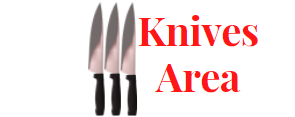Meet the best budget nakiri knife, the veggie virtuoso hailing from the Land of the Rising Sun. Here to chop through your culinary challenges with more finesse than a sushi chef doing knife tricks. This blade is like the superhero of the kitchen. Forged from the finest high-carbon stainless steel, this blade means business. It’s the superhero suit of the kitchen, balancing sharpness, durability, and rust resistance.
Now, let’s talk handles. Knife handle Wood is the name of the game here. Fashioned into a handle that’s as comfortable as your favorite pair of slippers. It’s got that full tang swagger, ensuring balance and durability. Traditional Japanese handles even come in D-shaped or octagonal designs. Why not add a touch of geometry to your chopping escapades?
This knife is all about veggies, not bones. Best budget nakiri knife like the vegetarian of the knife world—sensitive to the needs of your veggies. But not afraid to make them taste amazing.
In This Article —
- Best Budget Nakiri Knife -Our Top Picks Table
- Below is a Detailed Review of Our Best Budget Nakiri Knife
- What is The Best Use of a Nakiri Knife?
- Can a Nakiri Knife be Used for Meat?
- Nakiri Knife vs Chef Knife
- Process of Sharpening a Nakiri Knife?
- How Long Should a Nakiri Knife Be?
- FAQs
- Final Words
Best Budget Nakiri Knife – Our Top Picks Table
PRODUCT | DETAILS | CHECK PRICE |
Mercer Culinary Genesis 7-Inch Nakiri Vegetable Knife |
| |
Shun Cutlery Classic Nakiri Knife 6.5" Professional Nakiri Knife, Japanese Kitchen Knife |
| |
Babish High-Carbon German Steel Cutlery, 7.5" |
| |
WÜSTHOF Classic 7" Nakiri Knife |
| |
Kai PRO Wasabi Nakiri Knife 6.5", Ideal Chopping Knife for Vegetables, Great All-Purpose |
| |
Kyocera Revolution Kitchen, 6-inch Nakiri Knife |
| |
Yoshihiro VG-10 46 Layers Hammered Damascus Nakiri Japanese Vegetable Knife 6.5'' |
| |
Nakiri Knife, 7" Japanese Chef Knife,High Carbon Stainless Steel Professional Japanese cleaver, Multipurpose |
| |
6" Ceramic Vegetable Cleaver (Nakiri Knife) |
| |
ZWILLING Twin Fin Nakiri Knife (17 cm) |
|
Below is a Detailed Review of Our Best Budget Nakiri Knife
1. Mercer Culinary Genesis 7-Inch Nakiri
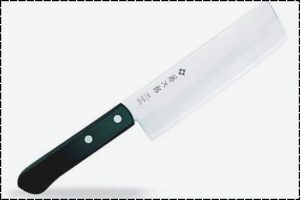
Introducing the Mercer Culinary M20907 Genesis 7-Inch Nakiri Veggie Blade. A kitchen Swiss army knife so keen it once diced a tomato by giving it the side-eye (almost). Forged from high-carbon, blemish-resistant German cutlery steel. This blade scoffs at dullness and stands up for veggie justice!
Its razor-straight blade and squared-off tip turn vegetable chopping into a precision ballet. Making every slicing task a culinary masterpiece. Sporting a 7-inch blade. It’s the Goldilocks of knives not too massive, not too petite. the perfect fit for all your veggie escapades.
But hold your knives, there’s more. The handle, crafted from Santoprene, isn’t a grip. This Nakiri a warm handshake for your hand. The bolster? It’s the unsung hero. The sidekick that brings equilibrium and protection to the soirée.
This blade is no one trick pony – it’s the rockstar of the kitchen. With complete tang construction. It’s so sturdy that it once conquered a mountain of veggies for kicks (okay, not, but it could). And did we mention it’s got panache? Cloaked in sleek obsidian.Ready to make a bold statement in your kitchen?
But here’s the kicker – it’s NSF-certified. It’s safety-certified. So you can trust it won’t start a revolution in your kitchen. To keep the blade keen, give it the spa treatment. Handwash, dry, and toss in a wisecrack or two for good measure. And don’t forget the honing rod. Because a blunt blade is like a humorist without punchlines.
Pros:
- Warranty -Lifetime warranty
- Easy Care -Hand Wash
- Razor-Sharp Knife
- Versatile Design
- Comfortable and Durable Handle
- Full Tang Construction
- Sleek Aesthetic
- High quality for the price knife
- Good weight – not too heavy
Cons:
- Spine and choil are not polished/rounded
- The pinch grip is less comfortable
2. Shun Cutlery Classic Nakiri Knife 6.5″

Introducing the Shun Cutlery Classic Nakiri Knife – the 6.5-inch kitchen sorcerer clever banter. Forged with more affection than your latest home-cooked feast. This blade is poised to make your veggies quiver and your culinary chores bow down.
This Japanese virtuoso isn’t a blade. Nakiri knife is a culinary superhero. Need to slice through veggies like a gastronomic ninja? The Nakiri blade, with its squarely-tipped finesse, declares I’ve got this. It’s the vegetable-vanquishing warrior. suited to transforming your kitchen into a battleground of flavors.
But let’s delve into aesthetics. Because even blades have a style sense. The chic ebony handle is not for display. There to elevate your kitchen’s allure. Cooler than an ice cream cone on a sweltering day. Additionally, this Nakiri knife is so comfy to grip that you might ponder if it delivers cozier embraces.
The blade is crafted from top-tier steel. It’s as resilient as your most recent attempt at cooking without scorching something. This knife is so razor-sharp. It could slice through your alibis for opting for takeout again.
Keep it with a bit of handwashing TLC, a swift post-use drying session, and the occasional honing. Whether you’re a seasoned culinary artist or a kitchen neophyte. The Shun Cutlery Classic Nakiri Knife is poised to render your kitchen exploits sharper.
Pros:
- A great looking functional knife
- Handle Material -Ebony color PakkaWood
- High-Quality Construction
- Traditional Japanese Design
- Handcrafted Nakiri
- Versatility useable Nakiri knife
- Aesthetics Nakiri
Cons:
- Classic Nakiri is expensive compared to other knives on the market.
- Not Dishwasher safe
3. Babish High-Carbon German Steel Cutlery, 7.5″
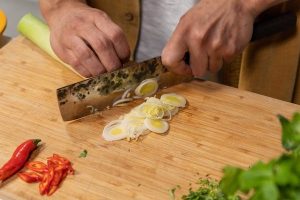
You’ve got your hands on the Babish High-Carbon German Steel the Beyoncé of kitchen knives. if you will. This bad boy isn’t a knife it’s the best budget nakiri knife in the culinary world. It earned itself the title of “Good Housekeeping Standout Knife of 2022.”
The blade is tougher than your bone meatloaf. And it won’t ditch you like that flimsy ex who couldn’t hold a conversation. It’s a knife made from high-carbon 1.4116 German steel. So it’s indestructible – take that. And with a 7.5″ clef (like a cleaver and chef’s knife a superhero). It’s like the Swiss Army knife.
Now, getting crowned as the “Standout Knife of 2022” is a big deal. I mean, it didn’t stand out. This knife did a kitchen tango that left everyone in awe. Good Housekeeping doesn’t hand out awards like candy this knife had to bring its A-game.
So, whether you’re a seasoned chef or trying not to burn your toast. This knife is the kitchen companion you never knew you needed. Now, go forth and conquer your kitchen like the culinary hero you were born to be!
Pros:
- For all-person fantastic budget knife
- High-carbon German steel knife
- With versatile designs, this knife combines features
- Full-tang handle comfortable grip
- Good Housekeeping Standout Knife of 2022 is no small
Cons:
- Although the weight of the knife depends on personal preference. The weight of this knife may be a drawback for some users.
4. WÜSTHOF Classic 7″ Nakiri Knife
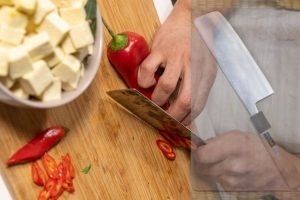
The WÜSTHOF Classic 7″ Nakiri Knife is a culinary maestro that chops veggies. With the precision of a stealthy ninja and the flair of a gastronomic rockstar. Forged by the German maestros this knife isn’t a kitchen tool. It’s a vegetable-slaying work of art.
Imagine this a blade so razor-sharp. it renders your neighbor’s chitchat as mundane as a worn-out fable. The 7 inches of high-carbon stainless steel transform your vegetable prep into a kitchen symphony. Akin to conducting with a lightsaber but for salads. Precision-crafted and boasting a full tang. This knife is the best for stability and equilibrium.
Now, let’s delve into the handle triple-riveted for added tenacity. It’s so robust you could use it as a makeshift paddle for navigating the gravy stream. And the equilibrium? It’s akin to wielding a magic wand that transforms vegetables into culinary masterpieces. This knife is more than a mere kitchen tool. it’s a trusty sidekick, a confidant.
Pros:
- Lightweight Nakiri knife
- Unwavering Stability knife
- This knife is Easy to use, Versatile Use
- Quality Construction
- Sharp Blade
- Razor-Sharp Precision
- Full Tang Design
- Comfortable Handle
Cons:
- Maintenance Demands
- Not Dishwasher-Friendly
- Considerable Investment
5. Kai PRO Wasabi Nakiri Knife 6.5″
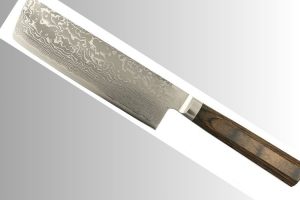
Introducing the Kai PRO Wasabi Nakiri Blade, a 6.5-inch virtuoso in the vegetable orchestra. Because why should veggies hog all the excitement? With a blade that’s straighter and a tip square. Enough to handle even the most intense kitchen theatrics. This knife turns chopping into a culinary salsa.
But wait – it’s not a veggie maestro. This Nakiri blade is the kitchen’s all-purpose best budget nakiri knife. Gliding through tasks with more finesse than a ninja in a produce bazaar. The flat blade isn’t for show it’s the enchanting wand. That transforms chopping, dicing, and slicing into a culinary sleight of hand.
Branded as the “Professional Nakiri Blade” it’s the rock star of the culinary cosmos. This blade aced the vegetable cutting course with flying hues.
This culinary consortium is where blades gather to swap zesty anecdotes. Forged with Japanese exactitude. It’s not steel; it’s Japanese steel so sharp. Well, it’s the unsung champion, the backstage pass to comfy and regulated slicing.
Before you unleash this kitchen dynamo, bear in mind: that it comes with its array of instructions. So, snag your Kai PRO Wasabi Nakiri Blade and let the culinary merriment – and chopping – begin or start!
Pros:
- High carbon stainless steel knife
- High-carbon, Polypropylene, Stainless Steel Hendel
- The quality exceeds the price
- Light weight knife
Cons:
- Maintenance Commitment: Maintaining this knife is like taking care of a high-maintenance friend. It needs love, attention, and a regular spa day. don’t forget to dry it off – unlike your favorite plant, this one doesn’t like staying damp.
6. Kyocera Revolution Kitchen Knife, 6-inch Nakiri
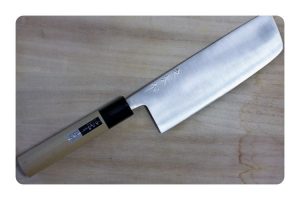 Presenting the Kyocera Revolution 6-inch Nakiri Veggie Slayer. The kitchen wizard you didn’t know you needed! Forged from zirconia ceramics. This blade is so unyielding it once engaged in an arm-wrestling match with a spud and emerged victorious. And it’s not pleasing. This Nakiri comes in a sleek ebony hue, the secret agent of kitchen cutlery.
Presenting the Kyocera Revolution 6-inch Nakiri Veggie Slayer. The kitchen wizard you didn’t know you needed! Forged from zirconia ceramics. This blade is so unyielding it once engaged in an arm-wrestling match with a spud and emerged victorious. And it’s not pleasing. This Nakiri comes in a sleek ebony hue, the secret agent of kitchen cutlery.
Crafted in the Nakiri fashion, this knife is the vegetable maestro of your culinary escapades. Boasting a 6-inch blade.Nakiri the Goldilocks of lengths – not large, not diminutive. the right size for slicing those veggies.
This knife is so razor-sharp, that it once sliced through gossip quicker than a celebrity hairstylist. The zirconia ceramic guarantees an edge. It stays keen for so long time your other blades might develop a tinge of jealousy.
Now, let’s discuss weight. This knife is lighter than a wisp on a summer breeze. You’ll be slicing and dicing with the grace of a ballet dancer, sans the tutu. But exercise caution, because ceramic can chip if not handled.
This Nakiri Veggie Slayer is the vegetable virtuoso. It can orchestrate a symphony in your kitchen with veggies as the notes. Meat and bones? So, there you have it – the Kyocera Revolution knife, your kitchen’s very own superhero humorist. Treat it, chuckle with delight, and let the chopping spectacle begin or start!
Pros:
- Durable Sharpness
- Feels light and easy to handle
- No metallic aftertaste
- Resists rust and corrosion
- Effortless cleanup
- Exceptional ceramic blades
- Will Not Oxidize Food
- Made in Japan
Cons:
- Handle with care
- Not an all-purpose tool
- Avoid heavy-duty tasks
7. Yoshihiro VG-10 46 Layers Hammered Damascus Nakiri
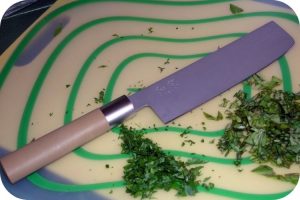
Behold the Yoshihiro Nakiri Blade – the kitchen’s best budget nakiri knife. From the HD Collection, born and bred in the culinary training ground of Japan. Envision this a 6.5″ blade shaped from VG10 Hammered Damascus Japanese Stainless Steel. It’s so keen it once slashed through the temporal dimension.
This knife that’s sharper than your repartee. The VG10 steel is so resilient it chuckles don’t of rust. And that hammered Damascus finish? Well, it’s not there to dazzle your dinner companions. Yoshihiro Nakiri is also perfect for ensuring your veggies glide off the blade as if they’re late for a soirée.
It’s the Goldilocks of blades, not large, not diminutive. perfect for a culinary escapade. This blade isn’t manufactured in any ordinary locale. This Nakiri crafted in the realm of the sunrise, Japan. So, when you’re brandishing it, you’re wielding a samurai sword.
Only wash and dry hands after using Nakiri and do so immediately if working with acidic materials. This blade has been known to transform average home chefs into vegetable-cutting virtuosos. A commendable blade is akin to a well-crafted jest – it should leave you yearning for more. Happy slicing!
Pros:
- Made in Japan
- Blade Material Stainless Steel
- Handle material alloy steel, handcrafted Octagonal Handle, lightweight and ergonomically welded.
- Blade Edge -Double-edged
Cons:
- Do not use Yoshihiro Nakiri on objects such as bones, nutshells, and frozen foods.
8. Nakiri Knife, 7″ Japanese Chef Knife
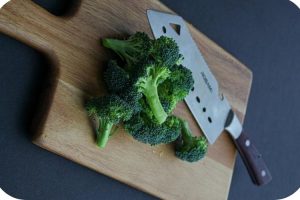
Introducing the 7-inch Japanese Culinary Blade, the kitchen maestro a cutting tool so keen. This Nakiri blade is the culinary companion you never knew you craved.
This blade is primed to chop, dice, and induce vegetable tears. It’s not a kitchen tool. Nakiri is a gastronomic virtuoso, tailored for both home gastronomes and professionals who navigate their way through the spice panorama.
At 7 inches, this blade is akin to the Goldilocks of the kitchen – not capacious, not petite, fitting for tackling anything from bell peppers to watermelons.
Crafted with the finesse of a sushi artisan and the tenacity of a marathon sprinter. This Nakiri blade is the Chuck Norris of kitchen cutlery. It’s so robust. It may have once cleaved through a tomato and minced an onion – and both teared up. And let’s not disregard the level blade blueprint, ideal for crafting culinary masterpieces.
So, as you embark on your epicurean exploits, remember to award this Nakiri blade with the affection it warrants. A touch of honing a mild hand scrub, and a pat-dry. Akin to a wellness retreat for your kitchen virtuoso. Now proceed, cleave as if nobody’s observing, and provoke laughter (or tears) from your vegetables!
Pros:
- High carbon stainless steel Nakiri knife
- Japanese Style
- Handle material -Stainless steel
- Blade Edge – Plain
Cons:
- Limited Versatility
- Blade a bit need high-maintenance
- China knife
9. Ceramic Vegetable Cleaver (Nakiri Knife) 6″

Presenting the 6″ Ceramic Veggie Slicer (Nakiri Blade) from Shenzhen Blades. Effortlessly cuts through vegetables with the finesse of a culinary ninja. Nakiri Blade is forged from top-tier ceramic.
In the realm of cutlery, this one’s a Nakiri – the maestro of mincing, master of chopping, and guardian of all things green. It’s like the lightsaber of the kitchen, only more practical for dicing zucchinis.
Now, let’s discuss Shenzhen Blades. The clandestine league of culinary artisans. Renowned for their enchanting utensil creations. They’ve summoned a blade that stays sharp longer than your preferred sitcom’s clever one-liners.
The handle is tailored to your grip like that ideal high-five – steady, congenial. And poised for action. It’s so cozy. You’ll be slicing onions without shedding a single tear.
Ceramic knives defy stains, corrosion, and aromas. It’s akin to possessing a blade that’s impervious to kitchen theatrics. Just remember, it’s a tad delicate, so no extreme culinary acrobatics.
So, whether you’re a kitchen sorcerer or merely someone yearning to feel like one. The 6″ Ceramic Veggie Slicer is your pass to kitchen grandeur. It’s so fantastic even your veggies will be giving a standing ovation.
The 6″ Ceramic Nakiri tapered rectangular-shaped blade. With larger size and heft, make it suitable for heavy-duty chopping and dicing of fruits and vegetables.
Pros:
- This Nakiri is Harder than steel and will hold the edge longer than a steel blade.
- Lightweight
- Will not rust
- Easy to clean
- Resistant to acids and oils
Cons:
- Do not chop on a hard surface only use a wooden chopping board.
10. ZWILLING Twin Fin Nakiri Knife
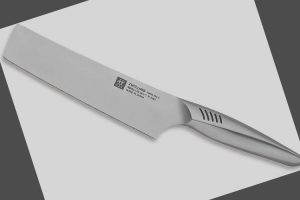
ZWILLING Twin Fin II Nakiri Knife is your kitchen’s new best friend. A 17 cm powerhouse of culinary awesomeness. Crafted by the maestros at ZWILLING, these folks have been perfecting the art of cutlery.
Now, let’s talk about that blade – 17 cm of pure slicing nirvana. It’s like the Excalibur of the vegetable world. Made from top-notch stainless steel, this blade is sharper.
The full tang construction isn’t chef jargon. It’s the secret sauce that makes this knife as balanced as a yoga instructor on a tightrope. Grip it, and you’ll feel like you’ve unlocked the achievement of the ultimate kitchen swagger. The handle? It’s not a handle. Ergonomic, sleek, and ready for action.
Now, let’s talk style. The Twin Fin II series is a kitchenware sophisticated, sleek it won’t leave you in the lurch. It’s so good-looking. You might catch it checking itself out in the reflection of your stainless steel fridge.
Maintenance? Easy hand wash, keep it with care dry it, sharp enough Nakiri Knife. Sure, ZWILLING knives might cost a bit. But think of it as an investment in your culinary dreams. Because when you’re wielding the Twin Fin II Nakiri, you’re not cooking – you’re putting on a show!
Pros:
- Dishwasher-safe Nakiri knife
- Balance and control and high-quality knife
- This Nakiri knife Handle ensures a comfortable and secure grip during use
Cons:
- High-quality knife often come with a higher price tag
What is The Best Use of a Nakiri Knife?

The best budget nakiri knife is a true ninja in the kitchen. Slices through vegetables with the finesse of a culinary samurai. Its sleek design is like a vegetable-slaying katana. Features a double-edged blade that’s flatter than your attempt at making pancakes.
This Japanese wonder is not a knife. Nakiri knife is a veggie magician. turning carrots into uniform slices faster than you can say. Is that a zucchini or a green spaceship? The Nakiri is to vegetables what a hair straightener is to curls. It brings order to chaos. It brings order to chaos.
Imagine wielding this culinary lightsaber for fine chopping. Best budget Nakiri knife like conducting a herb symphony. Mincing garlic becomes a breeze – vampires beware, the Nakiriis in town. It’s also the Picasso of the kitchen. Creating julienne and brunoise cuts that even vegetables would frame on their walls if they could.
But wait, there’s more. Need to slice tofu? The Nakiri does it with the precision of a ninja surgeon. It’s not a knife. It’s a vegetable whisperer. Ensuring that every slice, dice, and chop is as perfect as your grandma’s secret pie recipe.
And let’s not forget the presentation game. The Nakiri turns your veggies into edible art installations. Making your dish look so good that even the carrots are blushing.
In conclusion, the Nakiri knife isn’t a kitchen tool. Best budget nakiri knife a vegetable maestro, a garlic annihilator, and a presentation Picasso. So, grab your Nakiri and let the vegetable magic show begin.
Can a Nakiri Knife be Used for Meat?

The veggie virtuoso straight out of Japan, ready to dance through your produce like a seasoned salsa instructor. With its slender, rectangular blade. Best budget nakiri knifelike the Fred Astaire of the kitchen. Performing precise and graceful moves on every vegetable in sight. Slicing, dicing, and chopping become a culinary waltz. And if vegetables could applaud they would.
Now, the Nakiri might not have signed up for the meatballroom dancing classes, but hey, it’s a good sport. When faced with the tender cuts – the Channing Tatums of the meat world. This blade becomes the smooth operator. Slicing through boneless meats with the finesse of a gourmet ninja. Yet, when the meat starts flexing its bones or putting on its toughness act. The Nakiri might suggest a more robust partner.
Think of your kitchen as a comedy club, with each knife playing its unique stand-up routine. The Nakiri takes the stage, cracking vegetable jokes left and right. And , here comes the meat knife, the punchline specialist, ready to handle the tougher crowd. It’s a culinary improv, and your kitchen is the stage. Where every cut is a punchline and every meal a standing ovation.
Nakiri Knife VS Chef Knife

Nakiri Knife:
Characteristics: Imagine the Nakiri knife as the veggie rockstar of your kitchen. This knife has a straight, squared-off blade with a bit of height. It’s making it the cool cat of the cutting board. The blade is on the thinner side, so it’s like the slimmer, trendier sibling.
Best For: When it’s veggie time, the Nakiri steps into the limelight. It’s got a flat edge that breezes through slicing and chopping, and that squared tip? Well, the best budget nakiri knife is like the precision engineer of the vegetable world. It gives you cuts so sharp they could audition for a talent show.
Chef’s Knife:
Design Flair: Now, let’s talk about the chef’s knife – the kitchen multitool with a bit more curve and flair. It’s the Gandalf of knives, with its longer, pointy tip saying, “You shall not pass… without being chopped.”
Versatility Unleashed: The chef’s knife is the superhero of the kitchen drawer. Need to chop, slice, dice, or mince? It’s like a culinary Swiss Army knife, ready for action. It doesn’t discriminate. From meat to fruits and veggies, it’s the knife that says I’ve got this. stand back and watch the magic happen with the Nakiri knife.
So, in your kitchen saga, the best budget nakiri knife and chef’s knife are like a dynamic duo. One for veggies, the other for everything else. Together, they’ll turn your kitchen into a comedy show of culinary excellence.
Process of Sharpening a Nakiri Knife?
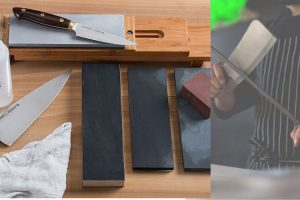
Getting Your Nakiri Knife Razor-Sharp! So, you’ve got this fantastic Nakiri knife, and it’s time to give it that sharp edge it deserves. Sharpening may sound a bit daunting, but fear not – it’s like giving your knife a spa day. Here’s your step-by-step guide:
What You’ll Need:
Sharpening Stones:
- Coarse (for the heavy lifting)
- Medium (to refine the edge)
- Fine (for that perfect, razor-sharp finish)
Knife Guide or Holder: Think of it as a trusty sidekick to help you maintain a steady hand.
Lubricant or Water: Keep things smooth with water for water stones or oil for oil stones.
Towel: Because a clean knife is a happy knife.
Steps:
Setup: Lay down a damp towel to keep those stones in place. Safety first!
Soak the Stones (if using water stones): Give your water stones a mini spa treatment by soaking them for about 10-15 minutes.
Inspect the Knife: Take a moment to check for any battle scars. If it’s got chips or bruises, start with the coarse grit stone.
Angle: Find that sweet spot – usually between 15 to 20 degrees. Check your knife’s vibe or consult the manual.
Start with Coarse Grit: It’s like exfoliating for your knife. Sweep it across the stone, both sides and say goodbye to the old, dull edge.
Move to Medium Grit: Time to refine things. Same dance, different stone.
Finish with Fine Grit: This is the fancy part. Polish that edge until it’s as sharp as a samurai sword.
Honing (Optional): A little bonus round with a honing rod or strop for that extra finesse.
Test the Edge: Slice through some paper or something soft. If it feels like butter, you nailed it. If not, repeat the dance.
Clean the Knife and Stones: Wipe down your knife, and give those stones a good wash. A dry party is a happy party.
Tips:
Consistent Angle: Like a good dance partner, keep that angle steady.
Light Pressure: Treat your knife gently – no need to press hard. Let the stone do the work.
Check Often: Don’t be shy to test the sharpness along the way. It’s like tasting your cooking; you want it just right.
Practice Safety: Sharp knives demand respect. Watch those fingers, and enjoy the process! There you have it – your Nakiri knife is now ready to tackle veggies like a pro chef. Happy slicing.
How Long Should a Nakiri Knife Be?

Deciding on a Nakiri knife is akin to discovering. It’s an ideal dance companion in the vegetable realm. With sizes fluctuating between 5.5 to 7 inches (14 to 18 cm). Best budget nakiri knife akin to selecting the sized dancing footwear. Whether you’re salsa-ing with cherry tomatoes or tango-ing with large cabbages.
Envision this Japanese vegetable blade as the conductor of your veggie symphony. Sporting a straight edge and a squared-off tip. Nakiri is not a knife. it’s the virtuoso directing the vegetable-chopping concerto.
When contemplating the selection of blade length. Liken it to choosing the dimensions of your superhero cloak. A more petite blade resembles a swift and agile superhero. While a lengthier one may evoke the sensation of a culinary. Nakiri superhero confronting colossal vegetable adversaries.
The best budget nakiri knife is more than a mere kitchen tool. Nakiri your vegetable confidant, your dance comrade, and your superhero cloak all amalgamated into one. So, opt for a length that feels fitting, and let the vegetable escapades begin or start.
FAQs
Question: What sets apart the best budget Nakiri knife?
Answer: So, what you want in the best budget nakiri knife is a combo of a sharp blade made with quality stainless steel or carbon steel. A handle that feels right, and a build that can take a beating. It’s about finding that sweet spot between cost and top-notch performance.
Question: Any preferences for the steel used in a budget Nakiri knife?
Answer: When you’re on a budget, stainless steel is your pal. It brings a good mix of sharpness, rust resistance, and easy maintenance. But hey, some blades also roll with high-carbon steel for that extra sharpness – keep an eye out for rust.
Question: What’s the sweet spot for the size of a Nakiri knife?
Answer: Nakiri knives usually strut their stuff in the 6 to 7-inch blade range. The right size? Well, that’s like asking if you like your coffee black or with cream – it depends on you. The 6.5-inch sweet spot is a good all-around choice.
Question: Full tang – yay or nay for Nakiri knives?
Answer: While a full tang is like the gold standard for toughness, few budget options flaunt it. No biggie. What you want is a handle that’s attached to the blade. Look for sturdy, trusty handles.
Question: What’s the scoop on handles – any recommendations for comfort and grip?
Answer: Think Pakkawood or TPE – these are your go-to for handles. They feel comfy, grip well, and can take a beating. It’s like finding the right handshake for your knife.
Question: Can a Nakiri knife handle more than veggies?
Answer: Sure thing! While Nakiri knives are veggie maestros, many can moonlight as all-purpose blades. keep in mind they might not be as versatile as your trusty chef’s knife. Veggies are their main stage.
Final Words
In concluding our exploration of friendly Nakiri blades. It’s plain we embark on a culinary journey in pursuit of the kitchen equal to Excalibur. A blade that won’t deplete the treasury but will dissect vegetables with the finesse of a seasoned chef. So, don your apron, and let’s plunge into this knife-centric odyssey. Where the chase for affordable brilliance collides with the keen edge of pragmatism.
As we carve through the alternatives, the Brand/Model Name emerges as the kitchen shadow. Cutting its path to the forefront of sensible Nakiri knives. It’s a fusion of premium stainless or carbon steel, a handle crafted akin to a culinary virtuoso. And a blade thickness as tuned as a maestro’s ear has earned accolades from home cooks far and wide. The best budget nakiri knife stands as the budget-conscious samurai in the realm of gastronomy.
